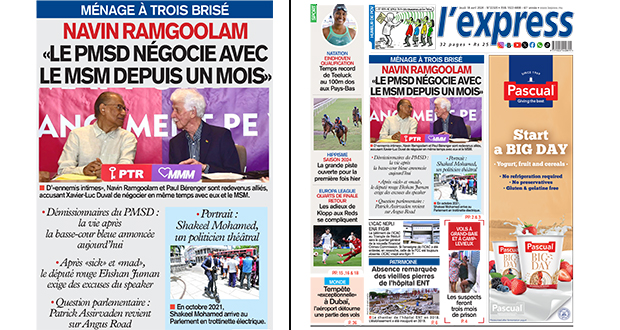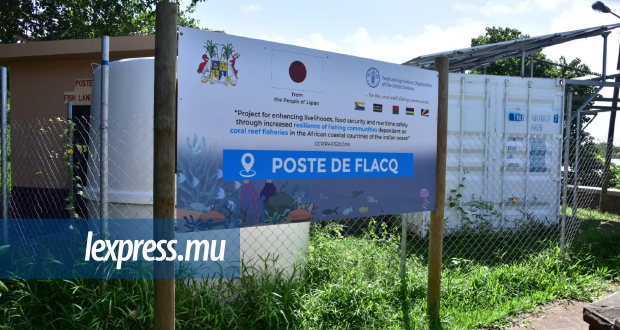Publicité
Golden Jubilee: In praise of the SSR National Hospital
Par
Partager cet article
Golden Jubilee: In praise of the SSR National Hospital


In the early 1950s, there were two small hospitals in the North, one in Montagne-Longue and the other in Poudre-d’Or. The other villages were provided with dispensaries. The Civil Hospital in Port-Louis treated the serious cases. The decision to build a new hospital for the districts of Rivière-du-Rempart and Pamplemousses was taken in 1956. Mauritius was just emerging from the epidemic of poliomyelitis with hundreds of children becoming handicapped overnight. They were to be provided with special shoes. A few of those victims are still alive.
The health of Mauritians in the 1950s
The population of Mauritius exploded after the Second world war as a result of the elimination of malaria, the increase in revenue due to the coming into force of the Commonwealth Sugar Agreement of 1950/51, and the soldiers were back home. It doubled within a decade. But the health conditions were far from good. The rapid growth of villages in the northern districts of Mauritius led to the transmission of diseases such as measles, typhoid, whooping cough, tetanus, contact dermatitis, tuberculosis and malaria.
Infectious and parasitic diseases were prevalent. Diarrhoea and lower respiratory system were the main cause of child mortality. Lack of hygiene in food preparation, improper disposal of human excreta and urine, untreated sewage discharged in rivers and contaminating the water were all responsible for the spread of communicable diseases such as cholera, typhoid, dysentery, infective hepatitis, trachoma, malaria and filariasis. Child mortality was on the increase as oral rehydration therapy was not available.
The public health services were ineffective. Neo-natal infections due to lack of immunization of mothers with tetanus toxoid, unhygienic delivery and unhygienic cord care during the first week of life led to neo-natal deaths. More than 60 % of maternal deaths were because of abortion, hypertensive disorders, haemorrhage and obstructed labour infections. On the other hand, there was lack of effective medical equipment, skilled health personnel and drugs. Deaths also came from injuries, fires, flames, motor vehicle accidents. Again, health education was ineffective. Malnutrition was also one of the leading causes of death. Babies were born too small to lead healthy lives. Mothers, too, were ill, malnourished and anaemic. Some measures such as the School Feeding Project providing free milk, bread, cheese and dried fruit to children, the supply of clean water, good sanitation, freedom from diseases and malnutrition were taken. Combating epidemic diseases in child mortality and fighting for safe pregnancy were going to be the public health service priorities of the coming Sir Seewoosagur Ramgoolam National Hospital.
The Sir Seewoosagur Ramgoolam National Hospital
Historically, the Sir Seewoosagur Ramgoolam National Hospital was built by the British government to cater for the public health needs of the citizens in Pamplemousses and Rivière-du-Rempart. Pharmaceuticals would transform the management of diseases. In October 1962, the British Firm of Architects, Mssrs Fry, Drew and Partners, were officially commissioned to design the “Central Hospital North”. A planning committee was appointed consisting of the Permanent Secretary of the Ministry of Health, specialists of different disciplines, engineers and architects of the Ministry of Works and Telecommunication to start the first phase. Its task was to discuss and agree upon the exact requirements of each of the departments and services to be created, to submit a detailed brief to the architects who would then translate it into sketch plans and cost estimates. There were consultations and discussions during 12 months. Her Excellency, Lady John Shaw Rennie, laid the foundation stone on the 9th of October, 1963.
There were regular meetings of the planning committee. It was agreed that the hospital would have 582 beds, comprising 28 wards and seven blocks of three storeys each, one self-contained Maternity Department with its own operating theatre, premature baby unit, milk kitchen, ante-natal clinics and delivery units, one Accident and Emergency Department complete with Operation Theatre, X-ray and Plaster Rooms. There would also be a central X-ray operating theatre, blocks with three theatres, Outpatients Medical Records, Central Sterile Supply Department, Physiotherapy, Pharmacy, Dental, Engineering and Instrument Curating workshops, Central Kitchen, Boiler House and an Administrative Block.
The gross estimation of the project was set at Rs 30 M. The project itself was divided into two phase. In July 1964, the Ministry of Finance provided a ceiling of Rs 24 M for the completion of Phase One. However, the pound sterling was devalued at that time so that the actual total cost of Phase One came up to Rs 28 M inclusive of furniture and loose equipment. The Memorandum of Agreement between the Government and Mssrs Fry, Drew and Partners was signed on 22 December, 1964. The Buildings Plans Committee approved the final plans in March, 1965.
Mr. D.K,White, Hospital Secretary, arrived in Mauritius in April 1965 to act as the Project Secretary for the scheme. Another year went by in preliminary work of quantity surveying and specifying each and every item of construction. In June 1966, the necessary contracts for Phase One of the Central Hospital North Project were signed finally. The contract stipulated that the work should be completed in two years’ time. On the 3rd October, 1968, the keys of the completed building were officially handed over to Mr. Harold Edward Walter, Minister of Health.
In January 1969, the Government of Mauritius had a very modern and fine hospital building. Now, the Ministry of Health had to breathe in life in the empty buildings and complete the institution that constituted a hospital. Phase Two concerned medical equipment and personnel. The equipment received from overseas was transferred to the “Central Hospital North”. The staff consisted of the Hospital Secretary, one Trainee Health Administrator, one Instrument Curator, and one Catering Officer on a three-year contract from the U.K. By May, 1969, it was decided that the hospital would bear the name of Sir Seewoosagur Ramgoolam, a worthy recognition of a dedicated leader. The opening ceremony was fixed for the 20th August, 1969.
The opening ceremony
On Wednesday, the 20th August, 1969, Sir Max Rosenheim K.B.E., M.A., M.D., F.R.C.P., Chairman of the British Council, unveiled the commemorative plaque in the presence of the Prime Minister, Sir Seewoosagur Ramgoolam, and Lady Sushil Ramgoolam. Their Excellencies, Sir Leonard Williams and Lady Williams, and members of the Legislative Assembly were among the 2,000 guests attending the opening ceremony. Addresses were delivered by Sir Max Rosenheim, the Right Honourable R. Prentice, P.C., M.P., Minister of Overseas Development, and the Honourable Harold Edward Walter, Minister of Health. They laid emphasis on public health service and its delivery at the SSR National Hospital in the northern districts of Mauritius. They stressed that attention would be devoted to decrease child and adult mortality, and due attention would be given to the importance of immunization and oral dehydration therapy. The Sir Seewoosagur Ramgoolam National Hospital would provide round the clock health services. Diseases like diarrhoea, pneumonia, bronchitis and diabetes would be treated effectively. In the field of prevention, public health service was also concerned with the supply of clean water, good sanitation, freedom from disease and freedom from malnutrition.
The administration
Mr D.K.White, Hospital Secretary, left Mauritius on the 12th August, 1969, at the end of his contract. Dr J.C. Mohith was appointed as the first Medical Superintendent on 15th December, 1969. He was responsible to the Permanent Secretary of the Ministry of Health and was in charge of the overall administration of the hospital. He had the direct responsibility for the organization of the medical and paramedical units such as Radiography, Laboratory, Pharmacy and Physiotherapy. The Chief Nursing Officers were responsible for nursing services. The hospital administration was responsible for “non-medical” services such as catering stores, medical records, instrument workshop, engineering, maintenance, domestic and cleaning staff.
Mrs E.Ramsoondar, Catering Officer, came to Mauritius in January, 1971, on a three-year contract. She reorganized the Catering Department. Training was given in modern cooking methods, proper use of electric equipment, general cleanliness and hygiene. There were ten cooks. The menu sheets were prepared one week in advance and sent to the wards. The Stores Department was responsible for the safe-keeping of medical equipment, surgical tools, fixtures and fittings for the Sir Seewoosagur Ramgoolam National Hospital. The Medical Records Department centralized all clerical work. The first hospital engineer was Mr. P.B.Howard. The Engineering Department was responsible for the provision of electricity, maintenance of high vacuum steam pressure, autoclaves, boilers, sewerage treatment, X-ray equipment and plants. The Central Sterile Department provided pre-packed and pre-sterilized materials and instruments for use in wards. The Domestic Staff had to ensure cleanliness and received appropriate training in the use of modern equipment
Conclusion
The Sir Seewoosagur Ramgoolam National Hospital is a space we step into when we are experiencing pain or a loved one is ill. We come to heal here. We surrender ourselves to care-givers and depend on them to make sure we return home safely. The hospital and the people it serves have a mutual relationship of trust and care. The hospital instils confidence in patients and safeguards their interests. Dignity and care are primordial so that it becomes a home away from home. The hospital has established itself as provider of quality health care since its inception. It has, with time, built a relationship within the community it serves. It is able to navigate pressures and provide patient-driven care.
Empathy and innovation are the hallmarks of the hospital. Through its warm, welcoming environment, it has adopted a humanized approach towards patients. It has stretched its helping hands throughout the North and even elsewhere through its two minor hospitals at Montagne-Longue and Poudre-d’Or, its mediclinics at Triolet and Goodlands, and 27 dispensaries. By 2018, it has brought medical cares and medicines inside the homes of the people it serves.
New therapies, technologies and improved diagnostics are pivotal for quality treatment. Collaboration and peer review among physicians and care-givers lead to high success rates. The hospital has set up One-Stop solutions to patients with multiple and complex problems. This saves them the effort of positive outcomes, fewer complications and lower treatment costs. The Sir Seewoosagur Ramgoolam National Hospital provides health care from “Bench to Bedside” for the well-being of the patient community in a comprehensive manner. It has achieved robust, world-class excellence in health care.
In the future, the hospital will be accountable to the consumer. The latter will demand stringent compliance to regulations, more personal care and transparent communication and information channels. The consumer will also look for attention to detail, the hospital’s promise and the delivery of the said promise together with the overall quality of its service.
Publicité
Les plus récents






